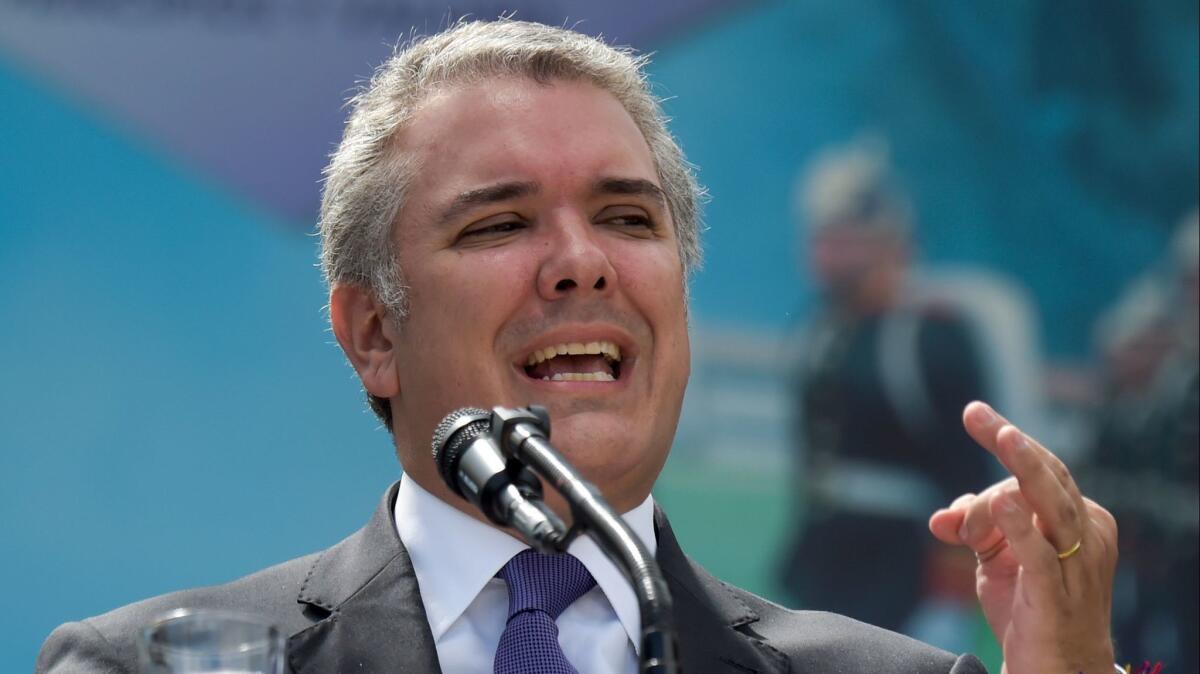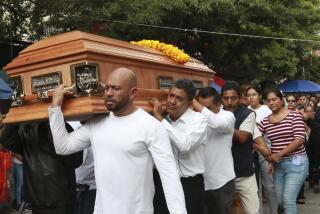Colombia’s lesser known rebel group still delivers violence and wreaks havoc

- Share via
Reporting from Bogota, Colombia — The Colombian rebel group known as the National Liberation Army delivered an unwelcome new year message, exploding two bombs on the Caño Limon-to-Coveñas oil pipeline in the eastern province of Arauca.
The Jan. 9 attacks disrupted delivery of crude to the Andean country’s major export harbor and caused nasty spills. Though no deaths were reported, the bombings illustrated how the nation remains plagued by insurgent violence that stunts economic development and wreaks havoc in rural areas despite the government’s peace agreement in late 2016 with the 14,000-member Revolutionary Armed Forces of Colombia, or FARC.
The National Liberation Army, better known as ELN, the initials for its name in Spanish, Ejercito de Liberacion Nacional, has grown in strength since the FARC demobilized, adding about 1,000 members to the 1,500 fighters it had before the peace deal, said Orlando Hernandez, a former officer with the Colombian National Police and now a security expert with the Agora Consulting risk analysis firm in Medellin. Many of the newer ELN members are former FARC fighters who declined to disarm, he said.
The violent means the ELN uses to pursue its social justice goals for poor or oppressed people have left it with slight public support. The government blames it for 5,700 kidnappings since 1996, and the group is believed to be holding about 250 people hostage. Officials also say the ELN has perpetrated 328 pipeline bombings since 2012, causing numerous oil spills and the loss of more than a million barrels of crude since the start of 2017.
On and off peace negotiations between the government and ELN since 2015 have been inconclusive. Near-term chances of a deal seem remote with new Colombian President Ivan Duque having criticized the FARC accord forged by his predecessor, Juan Manuel Santos, as too generous.
Vanda Felbab-Brown, a senior fellow at the Brookings Institution in Washington, said Duque is taking a hard line with the ELN, imposing a number of preconditions such as the release of kidnapped hostages, the end of criminal activities such as extortion and bombings, and the concentration of guerrillas in one remote site while peace talks are carried out. The rebels have been unwilling to meet those conditions, she said.
Here is some more information about the ELN:
What is the ELN’s ideology and when was it founded?
The group was established in 1964 by brothers Manuel and Antonio Vasquez Castaño and other Colombians studying in Cuba. Their objective was to import the Fidel Castro-led revolution to their home country and effect an armed takeover of the government.
The ELN espouses a violent brand of liberation theology that mixes Marxist politics with the Roman Catholic Church’s concern for the poor. One of the group’s icons was early recruit Camillo Torres, a priest who was killed in a 1966 battle with the Colombian army.
The U.S. government classifies the ELN as a terrorist organization.
Where did the ELN find members and financial support?
At the height of its power in the early 1990s, the ELN had about 9,000 members, with many recruits coming from labor unions — some were students and leftist intellectuals. Revenue came from extorting from mining and energy companies and kidnapping and seeking ransoms for oil company officials, wealthy farmers and cattlemen and others.
ELN membership declined in the 1990s after right-wing paramilitary militias were formed to fight the rebels, but it has grown since 2016 as the group turned to drug trafficking to generate revenue, Hernandez said.
How does the ELN differ from the FARC?
The FARC decided in the early 1990s to finance operations by aligning with drug traffickers, fueling nationwide expansion and dominance over rival insurgencies. By the time the FARC signed the peace deal, the group had gained control of much of Colombia’s cocaine supply chain. It financed farmers’ purchases of land and seeds for crops of coca, cocaine’s raw material; it secured transit routes and made deals with Mexican mafias, their main clients.
The ELN, meanwhile, remained focused mainly on the northeastern provinces of Arauca and North Santander, where it harassed and extorted from oil companies, especially state-controlled Ecopetrol, owner of the country’s oil and gas pipeline grids. The group initially gained influence by supporting worker strikes at the giant Barrancabermeja oil refinery.
How has the FARC peace accord affected the ELN?
Since the FARC demobilized, the ELN has attempted to fill the vacuum in the drug trafficking business, becoming an active player in the southern province of Nariño, a prime coca farming, processing and cocaine transit zone. But competition is intense, with criminal gangs, Mexican mafias and other rebel groups all vying for the lucrative cocaine market.
Like the FARC, the ELN uses Venezuela as a sanctuary, and its members are thought to receive medical treatment from the accommodating socialist government there.
Who is the ELN leader?
After the Vasquez Castaño brothers were killed by the army in 1973, the group was led by Spanish priest Manuel Perez Martinez, alias Poliarco, who died in 1998 from hepatitis.
Nicolas Rodriguez Bautista, alias Gabino, 68, assumed power after the death of Perez Martinez, assisted by four other block leaders in the Central Command, and he remains jefe maximo today. The Duque government recently asked the Cuban government to arrest and extradite Gabino on terrorism charges.
Why are the bomb attacks and kidnappings happening, and how many have there been?
The ELN uses bombings, kidnappings and the threat of such attacks to pressure oil companies to make extortion payments. The ELN considers all oil drilling sites and infrastructure to be military targets. Last year, the group was responsible for 108 bomb attacks, up from 63 in 2017, Hernandez said, citing police statistics. As for kidnappings, the rebels were blamed for 25 last year, up from 20 the year before, he said.
The ELN was thought to be responsible for the killings of several community leaders in places where residents resisted their attempts to extort from or impose on local governments, Hernandez said. The rebels were also suspects in revenge killings last year of several demobilized FARC fighters.
Why have peace negotiations failed so far?
In September 2015, after reaching a tentative peace agreement with the FARC, Santos announced he was in exploratory talks with the ELN and that formal negotiations would begin in 2016 in Quito, Ecuador. But a dispute over the kidnapping of a former congressman forced a postponement until February 2017.
The two sides in late 2017 announced a 90-day cease-fire ending in January 2018. The truce was not renewed, however, as the government accused the rebels of bad faith in attacking police and army installations. The talks were further stalled when Ecuador backed out as host after three Ecuadorean journalists were kidnapped and killed during a reporting trip to the common border. The base of negotiations then was transferred to Havana, where little progress was reported before Santos left office in August.
What are the chances negotiations will restart?
At the moment, not good.
Duque has not softened his stance on the preconditions for negotiations. The ELN recently declared a unilateral 10-day cease-fire during the holiday season but has refused to meet the president’s conditions.
Felbab-Brown said the ELN appears to face some organizational issues that might interfere with negotiations.
In recent weeks, he said, “there have been interesting developments, with the ELN sending a message through the Vatican that they wanted to negotiate. But the leadership structure is much more dispersed than the FARC, and it’s unclear who the negotiating partners would be and whether they can persuade the mid-level commanders to sign on.”
Kraul is a special correspondent.
More to Read
Sign up for Essential California
The most important California stories and recommendations in your inbox every morning.
You may occasionally receive promotional content from the Los Angeles Times.










